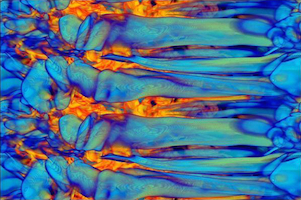
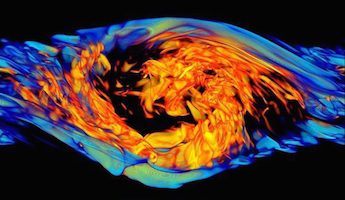
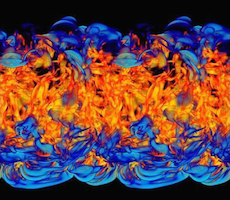
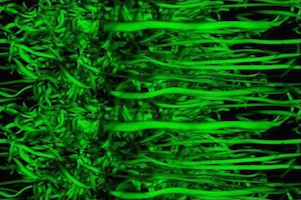
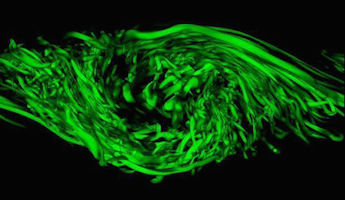
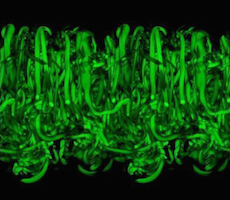
Overview
Dr. Werne has done extensive work on Kelvin Helmholtz (KH) instability and ensuing turbulence using the
NWRA Triple Code. Simulation validations have been made using balloon-borne rawindsone, tower,
aircraft, and radar data. Many new results have come from this work allowing the interpretation
of aircraft, radar, and cloud observations.
Three-dimensional volume-rendering animations are included below. Click on an image to view the
flow evolution.
Relevant publications reporting the findings are included below.
One of the most note-worthy findings from this work is the very different morphologies in
the evolutionary dynamics that result as the Richardson number is varied. For low Richardson
number (e.g., Ri=0.05), stratification is relatively weak, and the billows grow deep and round,
resulting in solid-body rotational stabilization of the cores. This suppression of core
instability enables secondary instability to develop first in the billow-periphery and braid
regions before finally appearing in the billow cores. When turbulence finally invades the
billow cores, it triggers a secondary peak in the turbulent kinetic energy.
The secondary instability in the billow peripheries is well documented in the literature, as
Ri=0.05 has been a favorite choice for study. Click on the dissipation
and vortex-tube visualizations included below to get a clear
depiction of the secondary instability, subsequent evolution, and ensuing turbulence for
the low-Ri case.
In contrast to the Ri=0.05 case, at high Richardson nubmer (e.g., Ri=0.20), the stronger
stratification inhibits deep billow formation, leading to sheared cores with imperfect overturning.
Such billows cannot be stabilized by a solid-body-like rotation, and, as a result, as soon as these
strongly stratified billow cores overturn, their inverted stratification renders them immediately
unstable, and turbulence develops and migrates outward from the cores. The braid regions between
billows remain stable the longest and succumbing to turbulence last.
To compare the different morphologies and dynamics for high and low Richardson numbers, see the
combined animations for three different Richardson numbers
below: Ri=0.05, Ri=0.15, and Ri=0.20.
Animations
The first animation shows three orthogonal views of the thermal (blue) and viscous (yellow)
dissipation fields for Ri=0.05 and Re=2500. As the flow evolves, the layer Reynolds number
Re_L=dU L/nu grows to Re_L=30,000, where dU, L, and nu are the velocity jump across the layer,
the layer depth, and the kinematic viscosity of the fluid. In the animation it is clear that
the vigorous mixing (intense yellow) at midlayer homogenizes the temperature field, reducing
the thermal gradients there, forcing strong thermal gradients near the edge regions of the
mixing layer. Since strong thermal gradients give rise to sharp variations in the
index-of-refraction field, optical turbulence effects are concentrated here in the edge region.
Hover over image for a brief animation (you must wait for movie to load).
Click here for full movie (132 Meg).
You are permitted to use this animation as long as you show the included credit to the authors.
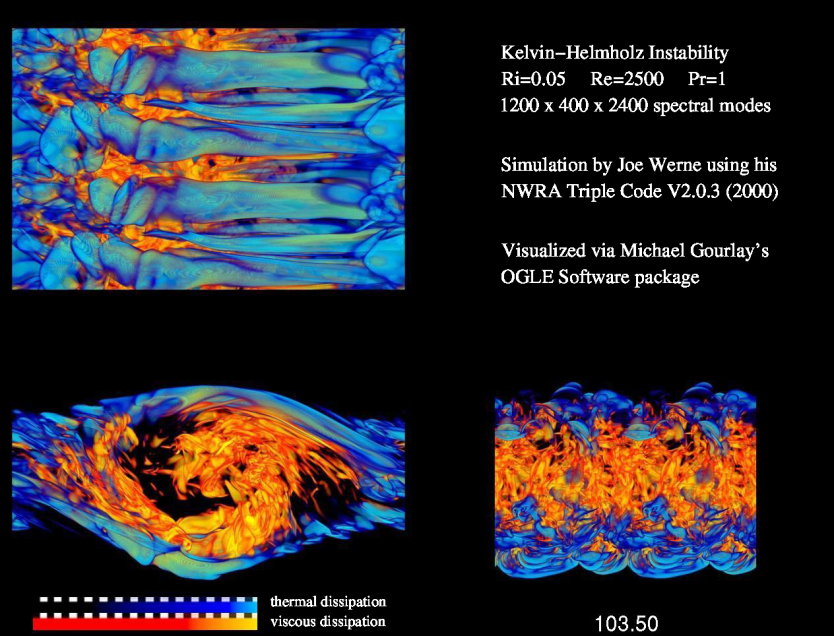 The second animation shows the vortex tubes in the Ri=0.05 case by depicting the negative
values of the intermediate eigenvalue of the S2+R2 matrix; here S and
R are the strain and rotation matrices (Jeong and Hussain 1995). Here the primary core is
sometimes faintly visible, but the vortex tubes in the secondary instability of the billow
periphery and their subsequent interaction and breakdown into an explosion of vortex tubes
is clearly visible as the flow evolves.
Hover over image for a brief animation (you must wait for movie to load).
Click here for full movie (113 Meg).
You are permitted to use this animation as long as you show the included credit to the authors.
The second animation shows the vortex tubes in the Ri=0.05 case by depicting the negative
values of the intermediate eigenvalue of the S2+R2 matrix; here S and
R are the strain and rotation matrices (Jeong and Hussain 1995). Here the primary core is
sometimes faintly visible, but the vortex tubes in the secondary instability of the billow
periphery and their subsequent interaction and breakdown into an explosion of vortex tubes
is clearly visible as the flow evolves.
Hover over image for a brief animation (you must wait for movie to load).
Click here for full movie (113 Meg).
You are permitted to use this animation as long as you show the included credit to the authors.
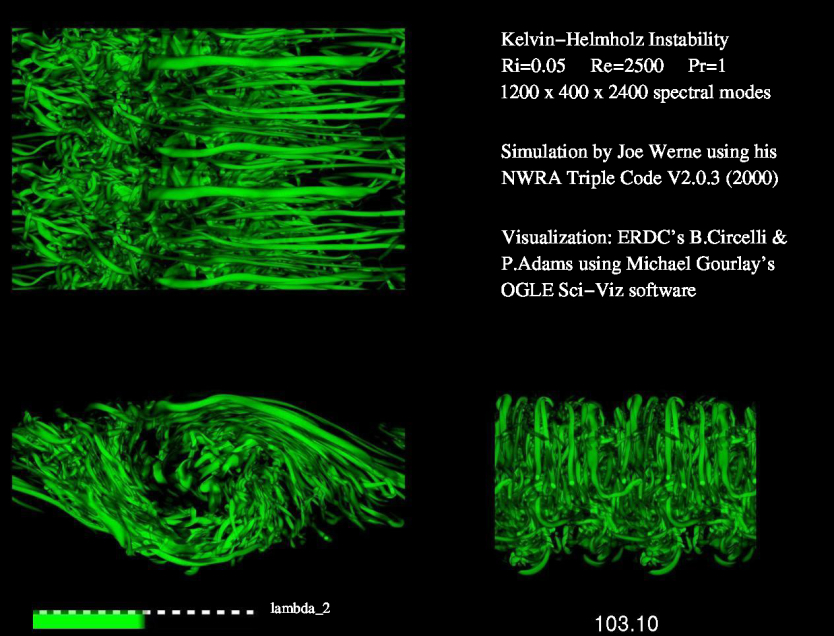 The final animation here shows the progressively flatter billows that result as Ri increases,
producing the very different morphologies described above in the overview.
Hover over image for a brief animation (you must wait for movie to load).
Click here for full movie (205 Meg).
You are permitted to use this animation as long as you show the included credit to the authors.
The final animation here shows the progressively flatter billows that result as Ri increases,
producing the very different morphologies described above in the overview.
Hover over image for a brief animation (you must wait for movie to load).
Click here for full movie (205 Meg).
You are permitted to use this animation as long as you show the included credit to the authors.
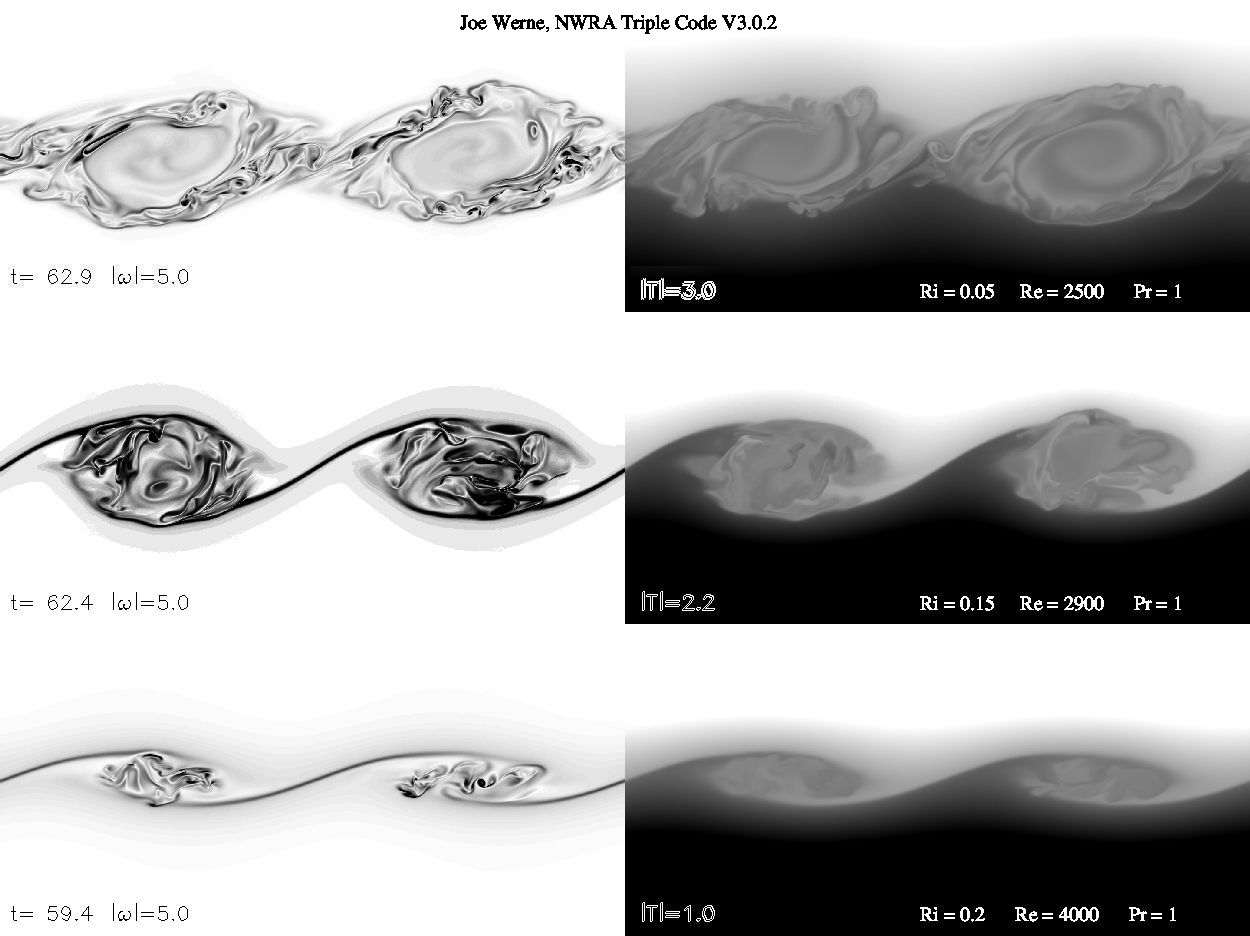 KH Publications Resulting from Triple
KH Publications Resulting from Triple
 The second animation shows the vortex tubes in the Ri=0.05 case by depicting the negative
values of the intermediate eigenvalue of the S2+R2 matrix; here S and
R are the strain and rotation matrices (Jeong and Hussain 1995). Here the primary core is
sometimes faintly visible, but the vortex tubes in the secondary instability of the billow
periphery and their subsequent interaction and breakdown into an explosion of vortex tubes
is clearly visible as the flow evolves.
Hover over image for a brief animation (you must wait for movie to load).
Click here for full movie (113 Meg).
You are permitted to use this animation as long as you show the included credit to the authors.
The second animation shows the vortex tubes in the Ri=0.05 case by depicting the negative
values of the intermediate eigenvalue of the S2+R2 matrix; here S and
R are the strain and rotation matrices (Jeong and Hussain 1995). Here the primary core is
sometimes faintly visible, but the vortex tubes in the secondary instability of the billow
periphery and their subsequent interaction and breakdown into an explosion of vortex tubes
is clearly visible as the flow evolves.
Hover over image for a brief animation (you must wait for movie to load).
Click here for full movie (113 Meg).
You are permitted to use this animation as long as you show the included credit to the authors.
 The final animation here shows the progressively flatter billows that result as Ri increases,
producing the very different morphologies described above in the overview.
Hover over image for a brief animation (you must wait for movie to load).
Click here for full movie (205 Meg).
You are permitted to use this animation as long as you show the included credit to the authors.
The final animation here shows the progressively flatter billows that result as Ri increases,
producing the very different morphologies described above in the overview.
Hover over image for a brief animation (you must wait for movie to load).
Click here for full movie (205 Meg).
You are permitted to use this animation as long as you show the included credit to the authors.
 KH Publications Resulting from Triple
KH Publications Resulting from Triple
- Fritts, Baumgarten, Wan, Werne, Lund 2014: "Quantifying Kelvin-Helmholtz instability dynamics observed in noctilucent clouds: 2. Modeling and interpretation of observations", J. Geophys. Res., Vol 119, pp 9359-9375, doi:10.10 02/2014JD 021833.
- Fritts, Wan, Werne, Lund, Hecht 2014: "Modeling the Implications of Kelvin-Helmholtz Instability Dynamics for Airglow Observations", J. Geophys. Res., Vol 119, doi:10.1002/2014JD021737.
- Franke, Mahmoud, Raizada, Wan, Fritts, Lund and Werne 2011: "Computation of clear-air radar backscatter from numerical simulations of turbulence: 1. Numerical methods and evaluation biases", J. Geophys. Res., DOI:10.1029/2011JD015895
- Fritts, Franke, Wan, Lund and Werne 2011: "Computation of clear-air radar backscatter from numerical simulations of turbulence: 2. Backscatter moments throughout the lifecycle of a Kelvin-Helmholtz instability", J. Geophys. Res., DOI:10.1029/2010JD014618
- Werne, Fritts, Wang, Lund and Wan 2010: "Atmospheric Turbulence Forecasts for Air Force and Missile Defense Applications", Invited Paper, 20th DoD HPC User Group Conference, 14-17 June, Schaumburg, IL, DOI:10.1109/HPCMP-UGC.2010.75
- Wroblewski, Werne, Cote, Hacker and Dobosy 2010: "Temperature and velocity structure functions in the upper troposhere and lower stratosphere from aircraft measurements (invited)", J. Geophys. Res., DOI:10.1029/2010JD014618
- Fritts, Laughman, Werne, Simkhada and Taylor 2009: "Numerical simulation of the linking of Kelvin-Helmholtz instabilities at adjacent shear layers", J. Geophys., Res. (to be submitted).
- Werne, Fritts, Wang, Lund and Wan 2008: "High-Resolution Simulations and Atmospheric Turbulence Forecating", 18th DoD HPC User Group Conference, July, Seattle, WA.
- Ruggiero, Mahalov, Nichols, Werne and Wroblewski 2007: "Characterization of High Altitude Turbulence for Air Force Platforms", 17th DoD HPC User Group Conference, June, Pittsburgh, PA., DOI:10.1109/HPCMP-UGC.2007.15
- Ruggiero, Werne, Mahalov, Nichols and Wroblewski 2006: "Characterization of High Altitude Turbulence for Air Force Platforms", 16th DoD HPC User Group Conference, June, Denver, CO.
- Werne, Lund, Pettersson-Reif, Sullivan & Fritts, 2005: "CAP Phase II Simulations for the Air Force HEL-JTO Project: Atmospheric Turbulence Simulations on NAVO's 3000-Processor IBM P4+ and ARL's 2000-Processor Intel Xeon EM64T Cluster", 15th DoD HPC User Group Conf. June 2005, Nashville, DOI:10.1109/DODUGC.2005.16
- Kelley, Chen, Beland, Woodman, Chau & Werne, 2005: "Persistence of a Kelvin-Helmholtz Instability Complex in the Upper Troposphere", J. Geophys. Res. Vol 110, D14106, doi:10.1029/2004JD005345
- Ruggiero, Werne, Lund, Fritts, Wan, Wang, Mahalov and Nichols 2005: "Characterization of high altitude turbulence for Air Force platforms", 15th DoD HPC User Group Conference, June, Nashville, TN.
- Helgeland, Andreassen, Ommundsen, Pettersson-Reif, Werne, Gaarder 2004: "Visualization of the Energy-Containing Turbulent Scales", 2004 IEEE Symposium on Volume Visualization and Graphics (VV'04) 103-109., DOI:10.1109/SVVG.2004.15
- Fritts, Bizon, Werne and Meyer 2003: "Layering accompanying turbulence generation due to shear instability and gravity wave breaking", J. Geophys. Res. Vol 108, D8, p 8452, doi:10.1029/2002JD002406.
- Pettersson-Reif, Werne, Andreassen, Meyer, Davis-Mansour 2002: "Entrainment-zone restratification and flow structures in stratified shear turbulence", Studying Turbulence Using Numerical Simulation Databases -IX, Proceedings of the 2002 Summer Program, Center for Turbulence Research, ed. P. Bradshaw, pp 245-256.
- Werne, Bizon, Meyer and Fritts 2001: "Wave-breaking and shear turbulence simulations in support of the Airborne Laser", 11th DoD HPC User Group Conference, June, Biloxi, MS.
- Werne & Fritts, 2000: "Structure Functions in Stratified Shear Turbulence", DoD HPC User Group Conference, Albuquerque, NM
- Werne & Fritts, 2000: "Anisotropy in a stratified shear layer", Physics and Chemistry of the Earth, Vol 26, p 263
- Gibson-Wilde, Werne, Fritts & Hill 2000: "Direct numerical simulation of VHF radar measurements of turbulence in the mesosphere", Radio Science, Vol 35, p 783.
- Gibson-Wilde, Werne, Fritts and Hill 2000: "Application of turbulence simulations to the mesosphere", Proc. MST 9 Radar Workshop, Toulouse, France.
- Werne & Fritts, 1999: "Anisotropy in Stratified Shear Turbulence", DoD HPC User Group Conference, Monterey, CA
- Werne & Fritts, 1999: "Stratified shear turbulence: Evolution and statistics", GRL, Vol 26, p 439.
- Hill, Gibson-Wilde, Werne & Fritts 1999: "Turbulence-induced fluctuations in ionization and application to PMSE", Earth Planets Space, Vol 51, p 499.
- Werne and Fritts 1998: "Turbulence in Stratified and Shear Fluids: T3E Simulations", 8th DoD HPC User Group Conference, Houston, TX.